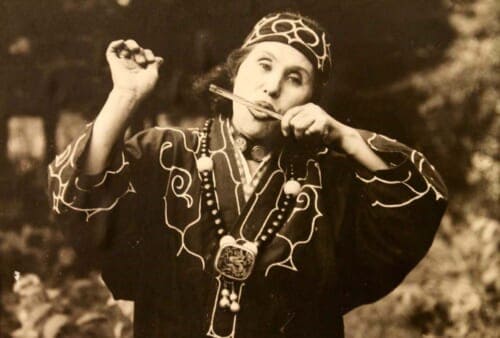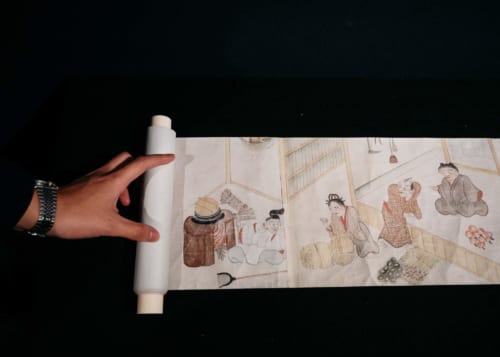Butoh (舞踏), a captivating Japanese dance form, strikes viewers with its profound surreality and raw, anti-aesthetic qualities when witnessed for the first time. Emerging in post-war Japan, this avant-garde dance defies simple categorization. It draws its power from the beauty that emerges from darkness and ugliness. Its minimalistic simplicity hides a deep complexity, transforming it into a unique artistic manifestation that challenges conventional notions of beauty and performance.
Butoh is a stark, visceral art form that invites you to explore emotional depths rarely touched by more traditional dance. You may be forgiven for struggling to watch it in its entirety when each performance turns into a personal encounter with the profound and the unsettling. Then, what makes Butoh so intriguing?
Butoh, a New Form of Expression
Post-WWII Japan was marked by intense social and cultural disarray. The impact of the war and the subsequent American occupation led to profound changes in Japanese society. A wave of Westernization and modernization that many felt eroded traditional cultural values. In this environment of uncertainty and transformation, artists began exploring new forms of expression that could encapsulate both their personal and national trauma and their hopes for regeneration.
It’s in this context that Tatsumi Hijikata (1928-1986) arrives at the inception of Butoh. This influential dancer was born in Akita and moved to Tokyo, dreaming of becoming a dancer. He learned ballet, jazz, and flamenco but soon grew dissatisfied with its limitations and began experimenting with his own style.
Shining Light on Taboo Subjects
It didn’t take long for him to start drawing attention. Hijikata’s early works were provocative and controversial. They were characterized by unusual movements and themes inspired by dark and taboo aspects of human existence. His Kinjiki (Forbidden Colors) performance in 1959, representing homosexual eroticism, is frequently cited as the first Butoh performance, an explosive challenge to existing norms and aesthetics.
In a way, he was seeking to break free from excessive Western influences. But at the same time, he was heavily influenced by the works of French writer Jean Genet, known for his works focused on the abject and the margins of society, as well as his poetic approach to theatre. He inspired Hijikata’s own revolutionary aesthetic and thematic choices in Butoh, seeking to highlight and elevate the outcast elements of society and the human psyche.
At the same time, the titular debut was a direct reference to Yukio Mishima’s works and his novel of the same name. Themes like the conflict between traditional Japanese values and Western ideas and Mishima’s obsession with beauty, eroticism, and death, resonated with Hijikata as he developed a dance form exploring similar ideas.
However, Butoh would not be what it is today without Kazuo Ohno (1906-2010) as its other seminal figure. After experiencing the horrors of war himself, Ohno embraced Butoh as soon as he met Hijikata, with whom went on to develop it. His approach to Butoh was more lyrical and surreal, emphasizing transformation and redemption through dance. His performances often explored themes of memory, gender, and resurrection, in stark but complementary contrast to Hijikata’s more confrontational style.
Philosophical and Artistic Foundations: What’s the Meaning of Butoh?
This way, Butoh transcends typical dance movements and becomes a medium for exploring deeper philosophical questions about life, death, despair and the absurdity of the human experience. The strange and often chaotic and convoluted way dancers use their bodies is a way to express complex emotions and states of being.
And it is precisely its raw and deeply personal nature that makes this dance so difficult to classify. But generally, a key aspect that we can identify includes a visual style consisting of performing with white body paint, with slow, hyper-controlled motion. Improvisation is also significant, allowing dancers to explore physical and emotional depths.
While Butoh is deeply Japanese, those human themes are universally appealing. Its revolutionary approach lies in its method of confronting these themes. Butoh strips away narrative constraints and conventional beauty, pushing the audience to confront raw, often uncomfortable emotions directly. In doing so, Butoh challenges viewers and performers to rethink the boundaries of art and the nature of human expression.
Worldwide Cultural Impact and Current State of Butoh
It didn’t take long for Western audiences to fall in love with Butoh. Its visual and thematic exploration of darkness, grotesqueness, and the surreal is a truly radical departure from the often more polished and aesthetically pleasing forms of Western performance art like classical ballet. But performed in such a way that the intense emotional expression and vulnerability displayed in Butoh performances can be profoundly moving. This raw, unfiltered exposure of human emotion speaks to audiences regardless of cultural background.
On the other hand, Butoh’s minimalist approach, focusing on slow, deliberate movements rather than elaborate choreography, emphasizes the expressivity of each gesture. Many consider this a refreshing change for audiences used to more dynamic and fast-paced performances, drawing them into a meditative state that is less commonly experienced in Western dance.
Coupled with frequent engagement with deep philosophical and existential questions, it results in a form of theatre that’s intellectually and emotionally stimulating. For Western audiences, this provides a unique lens through which to explore universal human concerns, further facilitated by the non-verbal, globally accessible nature of the dance.
It would be disingenuous, however, to discard the exotic appeal of engaging with a cultural form deeply rooted in Japanese history yet speaking to universal experiences. For Western audiences, it’s a cultural experience that provides insights into Japanese artistic expressions, merging the unfamiliar with the universal. Perhaps, creating a space where deep human emotions and existential questions are explored through a distinctly Japanese yet broadly accessible artistic form.
Domestic Recognition, With a Little Outside Help
Butoh’s original emergence challenged both the traditional Japanese arts and the prevailing Western influences on Japanese culture. As such, it was initially met with strong resistance. The initial goal was to create something uniquely Japanese and reflective of the post-war experience. However, like many avant-garde movements, its acceptance and acclaim abroad became a boost for its broader recognition at home in Japan.
Naturally, a phenomenon where cultural products or movements gain prestige and validation in their country of origin after being celebrated internationally isn’t unique to Butoh or Japan. But it’s interesting in this case how it reflects a complex interplay between national identity, cultural value, and global recognition, given Butoh’s origins.
The international success of Butoh not only highlighted its universal appeal and artistic merit but also encouraged a reevaluation of the art form within Japan, leading to greater acceptance and appreciation of its innovative approach to dance and performance art. This external validation played a key role in altering perceptions and increasing the legitimacy of Butoh within Japan’s cultural and artistic communities.
Contemporary Butoh in Japan
If you’re wondering where to see Butoh in Japan, fortunately, the contemporary Butoh scene remains vibrant, with several notable figures who have taken the art form in new directions, building on the foundational work of Hijikata and Ohno. Here are some of the most relevant Butoh figures in recent times:
Yoshito Ohno: Until his recent death in 2020, he kept alive the legacy of his father, Kazuo Ohno, as an important figure in keeping the traditional aspects of Butoh alive while also exploring new territories. He often performed and taught, providing a link between the original practitioners of Butoh and the new generation of dancers.
Dairakudakan: This Butoh troupe, led by Akaji Maro, is another highly influential seminal group. Founded in 1972, Dairakudakan produces large-scale ensemble works that are dramatic and often imbued with a sense of the fantastic or surreal. Maro’s work is theatrical, using elaborate sets and costumes, and his performances often incorporate elements of Japanese mythology and folklore.
Sankai Juku: The late Ushio Amagatsu founded Sankai Juku in 1975, today one of the most internationally renowned Butoh companies. Amagatsu’s work was known for its poetic and visually stunning performances that often explore universal themes of life, death, and rebirth. Sankai Juku performs worldwide, bringing Butoh to global audiences with a style emphasizing beauty and transcendence.
Min Tanaka: Although he has departed from the Butoh umbrella but is still considered an avant-garde dancer, he used to be related to Hijikata’s Butoh. His approach to the art involved a concept he calls “body weather,” exploring the relationship between the body and the environment. He emphasizes the physical rigor and connection with natural landscapes in his performances, often done outdoors and using the setting as an integral part of his expression. Tanaka also appears as the homeless dancer in Wim Wenders’ acclaimed movie Perfect Days which was set entirely in Tokyo.
It’s fascinating, then, to see how Butoh has evolved from a specific cultural response to a versatile and globally recognized form of artistic expression. Its adaptability and depth have allowed it to remain relevant in contemporary arts, continuing to challenge and inspire audiences around the world.










No Comments yet!